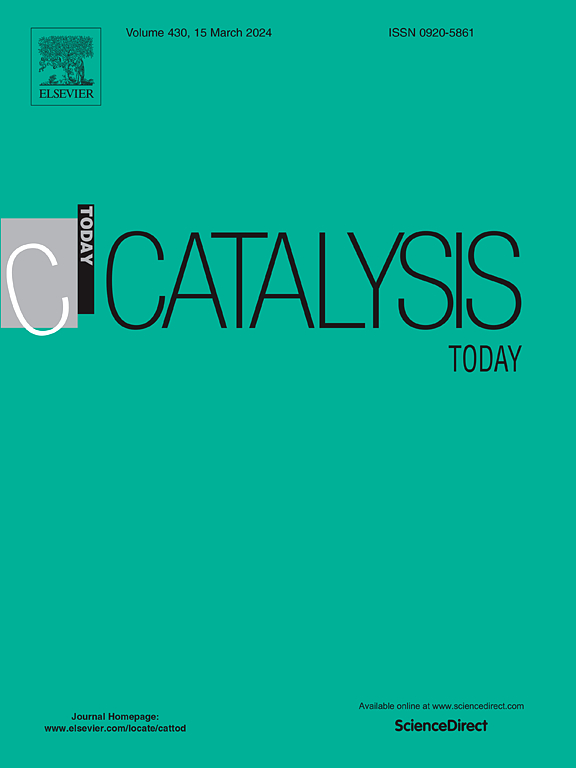Photocatalytic oxidation of 2,4-D by g-C3N4-CuFe2O4 catalyst: statistical modeling and optimization via Box–Behnken design
IF 5.2
2区 化学
Q1 CHEMISTRY, APPLIED
引用次数: 0
Abstract
Response surface methodology (RSM) is an outstanding tool for optimizing pollutant photodegradation processes that involve many complex operational factors. This study aims to model and optimize the photodegradation parameters of 2,4-Dichlorophenoxyacetic acid (2,4-D) using a Z-scheme g-C3N4-CuFe2O4 catalyst, with a Box–Behnken design (BBD) as the RSM statistical model. The effects of independent variables such as the g-C3N4-CuFe2O4 catalyst with different loadings of g-C3N4 (X1), reaction time (X2), initial 2,4-D concentration (X3), catalyst dosage (X4), and solution pH (X5) on 2,4-D photodegradation were studied. All independent variables tested during 2,4-D photodegradation were found to be statistically significant based on the ANOVA results. The results show that the amount of g-C3N4 introduced into the CuFe2O4 structure had the most significant influence among the variables on 2,4-D photodegradation. The photodegradation efficiency predicted by the BBD model was 98.21 % under optimal operating conditions, including a solution pH of 5.0 using 1000 mg/L of g-C3N4(2 %)-CuFe2O4 at an initial 2,4-D concentration of 20 mg/L. The actual 2,4-D photodegradation efficiency was close to the predicted value (97.78 ± 0.80 %), suggesting that BBD can be effectively used to optimize 2,4-D photodegradation using a Z-scheme g-C3N4(2 %)-CuFe2O4 catalyst under visible light. The enhanced photodegradation efficiency of 2,4-D is mainly due to the effective separation of photoinduced electron–hole pairs and the formation of highly active species (O2•− and OH•) in the Z-scheme g-C3N4-CuFe2O4 heterojunction system. Furthermore, g-C3N4(2 %)-CuFe2O4 is durable and easily recycled and reused many times in succession, showing great application potential in the removal of toxic pollutants through the efficient use of solar energy.
g-C3N4-CuFe2O4催化剂光催化氧化2,4- d: Box-Behnken设计统计建模与优化
响应面法(RSM)是优化涉及许多复杂操作因素的污染物光降解过程的杰出工具。本研究以Box-Behnken设计(BBD)为RSM统计模型,采用Z-scheme g-C3N4-CuFe2O4催化剂,对2,4-二氯苯氧乙酸(2,4- d)的光降解参数进行建模和优化。考察了g-C3N4- cufe2o4催化剂不同负载g-C3N4 (X1)、反应时间(X2)、2,4- d初始浓度(X3)、催化剂投加量(X4)、溶液pH (X5)等自变量对2,4- d光降解的影响。根据方差分析结果,在2,4- d光降解过程中测试的所有自变量都具有统计学显著性。结果表明,g-C3N4在CuFe2O4结构中的引入量对2,4- d光降解的影响最为显著。在最佳操作条件下,当初始2,4- d浓度为20 mg/L, g-C3N4(2 %)-CuFe2O4溶液pH为5.0时,BBD模型预测的光降解效率为98.21 %。实际的2,4- d光降解效率接近预测值(97.78 ±0.80 %),表明在可见光下,使用Z-scheme g-C3N4(2 %)-CuFe2O4催化剂,可以有效地利用BBD优化2,4- d光降解。2,4- d光降解效率的提高主要是由于在Z-scheme g-C3N4-CuFe2O4异质结体系中光敏电子-空穴对的有效分离和高活性物质(O2•−和OH•)的形成。此外,g-C3N4(2 %)-CuFe2O4耐用且易于连续回收和重复使用,通过有效利用太阳能在去除有毒污染物方面显示出巨大的应用潜力。
本文章由计算机程序翻译,如有差异,请以英文原文为准。
求助全文
约1分钟内获得全文
求助全文
来源期刊

Catalysis Today
化学-工程:化工
CiteScore
11.50
自引率
3.80%
发文量
573
审稿时长
2.9 months
期刊介绍:
Catalysis Today focuses on the rapid publication of original invited papers devoted to currently important topics in catalysis and related subjects. The journal only publishes special issues (Proposing a Catalysis Today Special Issue), each of which is supervised by Guest Editors who recruit individual papers and oversee the peer review process. Catalysis Today offers researchers in the field of catalysis in-depth overviews of topical issues.
Both fundamental and applied aspects of catalysis are covered. Subjects such as catalysis of immobilized organometallic and biocatalytic systems are welcome. Subjects related to catalysis such as experimental techniques, adsorption, process technology, synthesis, in situ characterization, computational, theoretical modeling, imaging and others are included if there is a clear relationship to catalysis.
 求助内容:
求助内容: 应助结果提醒方式:
应助结果提醒方式:


